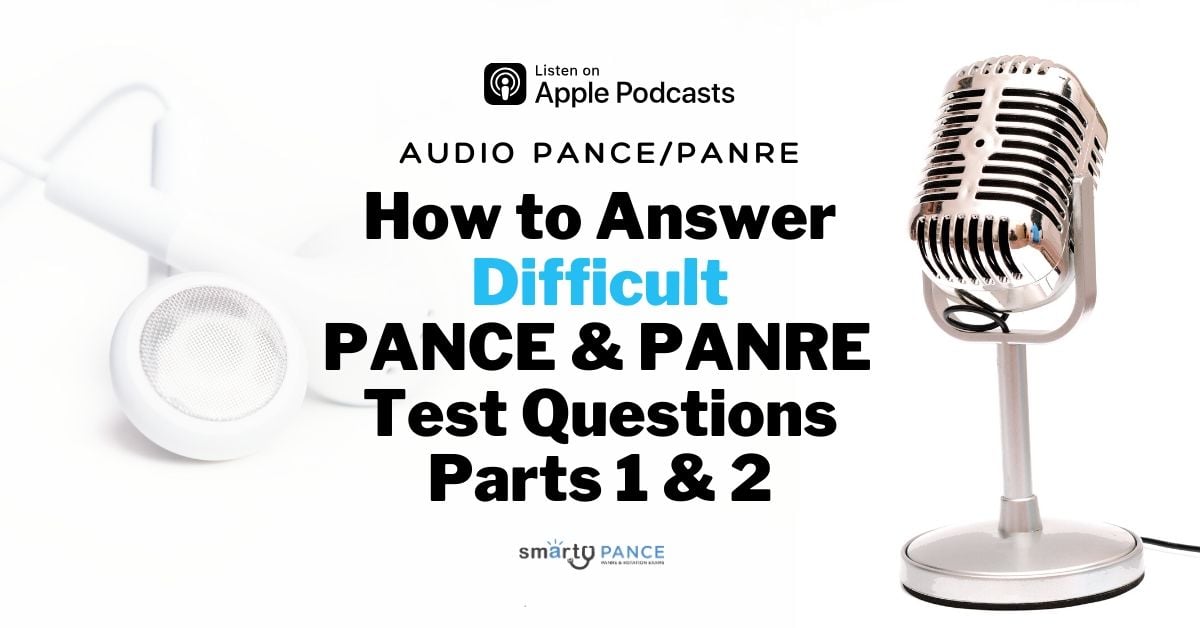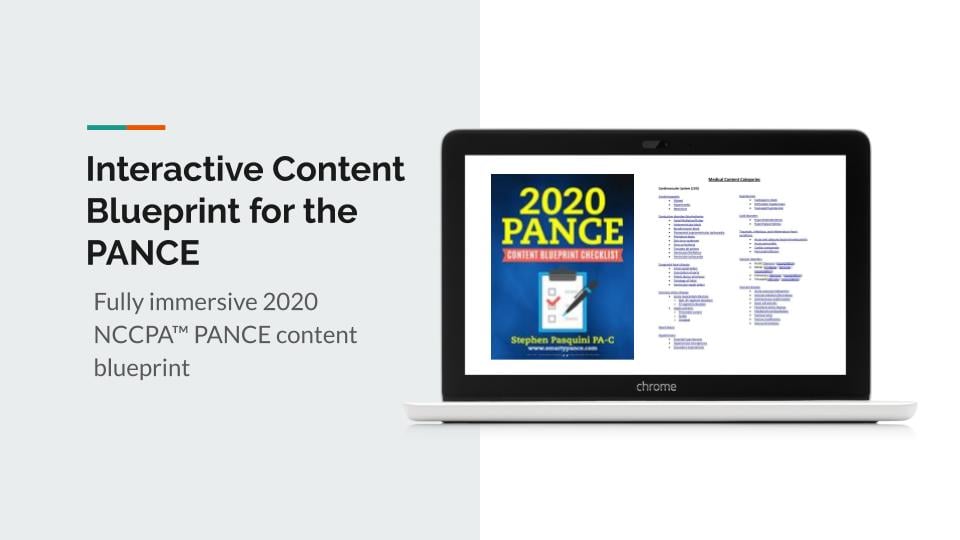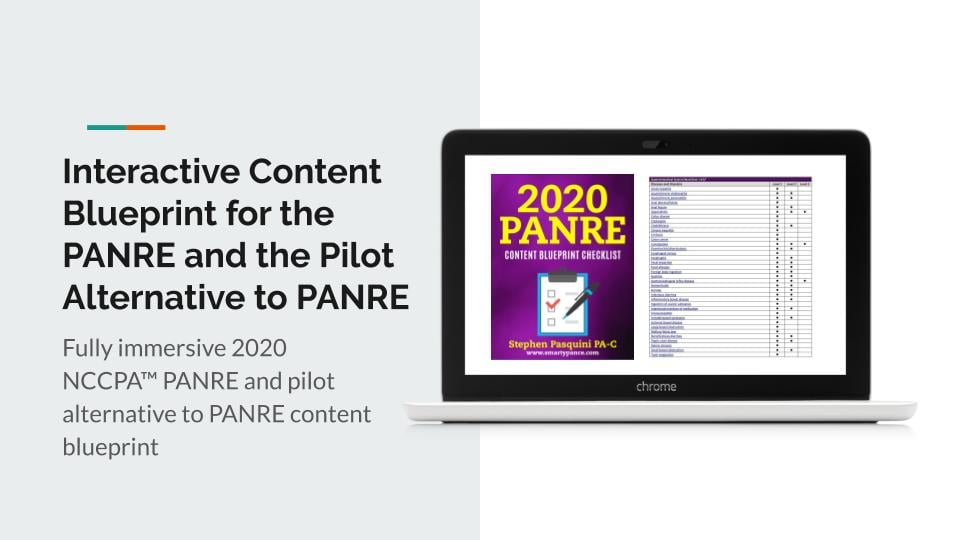In this podcast compilation from The Audio PANCE and PANRE Board Review Podcast, Joe Gilboy PA-C discusses best practices for answering the most difficult PANCE and PANRE test questions.
If you are not already subscribed to the podcast, you can download and listen to past FREE episodes here, on iTunes, Google Play Music, or just search for "The Audio PANCE" in your podcast app search bar.
Podcast Episode 82: How to Answer The Hardest PANCE/PANRE Test Questions Part 1
Click here to view the full-length blog post for podcast episode 82
Podcast Episode 83: How to Answer PANCE and PANRE Test Questions Part 2
Click here to view the full-length blog post for podcast episode 83
Questions and Audio Clips From Part 1:
The following questions are linked to NCCPA Content Blueprint lessons from the Smarty PANCE and PANRE Board Review Website
Question 1: Developing good test-taking habits
1. 10-year-old boy presents to the emergency department complaining of sudden onset lightheadedness and chest discomfort, vital signs, 98.6, heart rate of 205, respiratory rate of 30 and 98% oxygen saturation, his EKG demonstrated sinus tachycardia with no p waves. What is the most likely diagnosis?
- A-fib
- A-flutter
- Atrioventricular reentry tachycardia
- V-tach
Steps to answering this question
Question 2: Choosing between two good answers
2. A 60-year-old woman with a history of hypertension, dyslipidemia, and coronary heart disease was sent to the emergency room from her primary care physician's office for a heart rate of 40. She has no complaints, except for mild fatigue. Medications include metoprolol, atorvastatin, lisinopril, and baby aspirin. Her EKG reveals sinus bradycardia and her physical exam is normal. Which of the following is the most appropriate next step and management?
- Atropine
- Make a medication adjustment
- Schedule for a temporary pacemaker
- Watchful waiting
Steps to answering this question
Question 3: The long test question
3. A 32-year-old previously healthy man comes to ER with a four-hour history of palpitations. He denies chest pain, shortness of breath or history of similar palpitations. He does admit to heavy alcohol use in the past week drinking one pint of vodka and 24 packs of beer each day in the ED his vital signs of blood pressure 135/75, heart rate of 115, respiratory rate of 14, and oxygen saturation of 98% on room air. He's got an irregularly irregular rhythm heard on auscultation and EKG shows atrial fibrillation. What is the next step in management?
- Chemical conversion
- Observation
- Rate control
- Synchronized cardioversion
Steps to answering this question:
Question 4: The short question with long answer choices
4. Which of the following patients should be classified as having unstable angina?
- A 51-year-old woman who has chest pain three days ago, but is now chest pain-free, is found to have a positive troponin with q waves in II, III, and aVF without ST-segment elevation
- A 55-year-old woman with a history of hypertension, but no prior cardiac disease who complains of one episode of chest pain that began while pushing her grocery cart and lasted 30 minutes
- A 65-year-old male with a known history of coronary artery disease who gets chest pain and shortness of breath every time he climbs the steps to his bedroom
- A 71-year-old man who underwent a coronary cardiac catheterization one month ago for early morning chest pain but shows minimal coronary artery disease with no fixed lesions presents with recurrent early morning chest pain that is relieved with nitroglycerin
Steps to answering this question:
Selected Audio Clips From Part Two:
Here are selected audio tips from today's episode covering the most important points.
How to answer: "What is the most accurate test (what is the gold standard)?"
How to answer "What would you like to do next?" or "What is the next step?"
How to answer: "What's the most likely answer/diagnosis - which one fits best?" (the simplest answer always wins)
In other words, if something carries 51% weight versus 49% weight, the 51% weight wins.
How to answer: "What is the most common etiology?"
How to answer: "What is second-line therapy?"
Looking for all the podcast episodes?
This FREE podcast series is often limited to every other episode, you can download and enjoy the complete audio series by becoming a Smarty PANCE member.
For current members just click here to access or download all the past episodes.
Additional Resources from this episode
- Check out the new Smarty PANCE Internal Medicine Rotation (EOR) Review Course
- Download your Free Trello Smarty PANCE PAEA Internal Medicine EOR Tracking Template
- Take the FREE Internal Medicine Rotation Cardiovascular Practice Exam
- View the interactive Smarty PANCE Internal Medicine Rotation (EOR) Topic List
- Follow Smarty PANCE and The Daily PANCE Blueprint on Instagram
- Follow Smarty PANCE and The Daily PANCE Blueprint on Facebook
- My list of recommended PANCE and PANRE review books
- Interactive PANCE and PANRE NCCPA Exam Content Blueprints
- Sign up for the FREE Daily PANCE and PANRE email series
- Join the Smarty PANCE NCCPA Content Blueprint Website
- Get your free Trello PANCE study schedule
- Get 20% of any Picmonic membership by using this link
This Podcast is also available on iOS and Android
- iTunes: The Audio PANCE and PANRE Podcast iTunes
- Stitcher Radio: The Audio PANCE and PANRE Podcast Stitcher
- Google Play: The Audio PANCE and PANRE Podcast Google Play
Download The Content Blueprint Checklist
Follow this link to download your FREE copy of the PANCE Content Blueprint Checklist
Print it up and start crossing out the topics you understand, marking the ones you don't, and making notes of key terms you should remember. The PDF version is interactive and linked directly to the individual lessons on Smarty PANCE.







